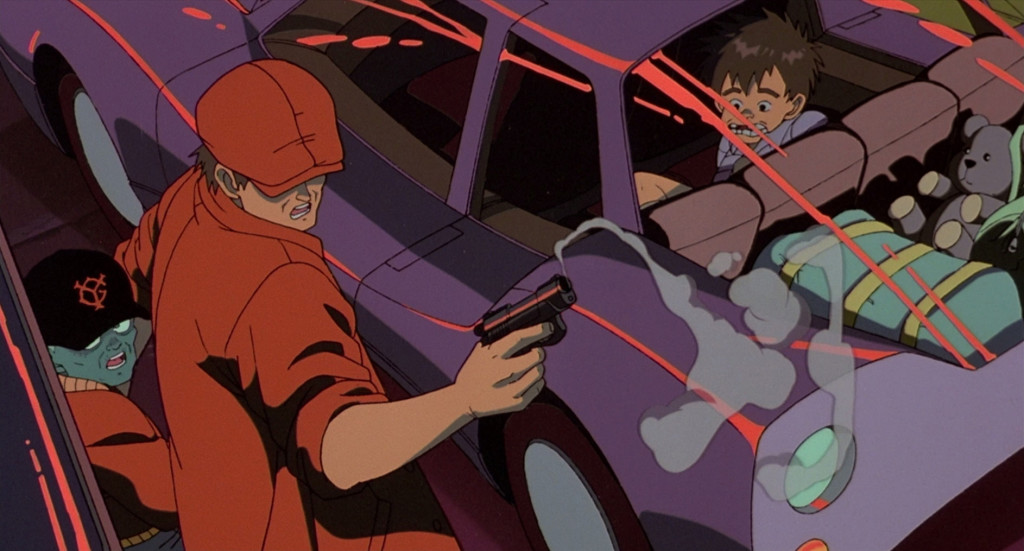
Both Akira and Godzilla show the influence of World War II, the nuclear age, and the US Occupation. Akira, being from 1988, is further removed from all of this compared to Godzilla, but the anime is set in a world where Tokyo is nuked and World War III starts. Both movies look at what nuclear war can mean (Cholodenko, 2014).
I will spare you the usual summary of Akira. There are plenty of summaries floating around the net. The film remains popular because it plays on the fears of a future outside our control (like that of Godzilla), and the film is the timeless story of an alienated teen searching for identity. It is full of stubborn adolescent resistance to what should be (Napier, 2001). Who doesn’t like a story about someone who is able to go their own way? Especially when the person wins against a rotten society. While Akira takes a (then) fresh look at these ideas, the film changed anime in several ways that are more important than why Akira resonated with so many people.
Let’s take at look at why Akira is important beyond the themes of the film.
What did Akira Change?
Godzilla was the first Japanese film to make it into the Western entertainment market. The second? Akira (Cholodenko, 2014). Now, the US was already familiar with anime. Speed Racer came out in 1967, after all. However, Akira was something different. Something adult and violent.
Akira’s animation style contrasted to that of Warner Bros. and Disney. Akira’s hyper-realistic, hyper-violent, dark style had more in common with live action than what Westerners considered animation. Akira even makes fun of the idea that animation must always be cute. The film laid the groundwork for later dark, adult films like Ghost in the Shell.
Akira changed the way anime was made. Anime was long thought to be a primitive style of animation. Well, it was for those in the West who knew about it. Americans were used to the stilted animation of Speed Racer and Voltron. Both were kids shows too. Then Akira burst onto the scene with a ¥1.1 billion budget (Hennum, 2013). In US dollars today, that is about $19,087,958. Land Before Time (which came out the same year) had a budget of $12.3 million – $24.6 million today (The Land Before Time, n.d.). The budget was on par with the American animation leaders of the time.
Akira also laid the foundation for how anime is products today (Hennum, 2013).
 First, the film raised the standards of anime. It used 160,000 animation cels. Gone were the still frames with speed lines and other shortcuts.
First, the film raised the standards of anime. It used 160,000 animation cels. Gone were the still frames with speed lines and other shortcuts.
Next, it was the first anime to prerecord its dialog. Before Akira, animation was done first, then dialog was recorded. This was cheap and often led to odd slips in dialog and animation. I’m sure you’ve seen anime where the lip animation didn’t match what was being said. Akira put quality ahead of cost and set the standard for most anime produced from then on.
The film explored cinematography in ways not handled in most animation. The camera zooms and pans like a live-action camera would. While we take this for granted today, the camera work of Akira made it feel closer to live-action than animation. The camera moved smoothly with the action rather than mostly stay stationary.
Most importantly, Akira opened the door for adult targeted animation. Anime like Cowboy Bebop and Ghost in the Shell.
The Influence of the Manga
 Akira came out before the manga that inspired it was finished. Katsuhiro Otomo’s style influenced Neon Genesis Evangelion’s character designer Yoshiyuki Sadamoto. Before Otomo, only the Osamu Tezuka school of Japanese cartooning was taken seriously (Hennum, 2013). Otomo, along with Shotaro Ishinomori (Cyborg 009) and Akira Toryiama (Dragonball) laid the foundation for manga storytelling post Tezuka.
Akira came out before the manga that inspired it was finished. Katsuhiro Otomo’s style influenced Neon Genesis Evangelion’s character designer Yoshiyuki Sadamoto. Before Otomo, only the Osamu Tezuka school of Japanese cartooning was taken seriously (Hennum, 2013). Otomo, along with Shotaro Ishinomori (Cyborg 009) and Akira Toryiama (Dragonball) laid the foundation for manga storytelling post Tezuka.
Tezuka favored simple backgrounds and character designs. Otomo, on the other hand, drew detailed environments and more detailed characters. Otoma’s work influenced many American comic artists such a Paul Pope and Jim Lee. (Hennum, 2013).
Akira continued to be enjoyed because of its exploration of dystopian society. It is also just a good story that is full of action. Akira changed the face of anime in the West, and showed us how animation is not just for children. The film laid some of the standards anime viewers take for granted today, such as animation quality and cinematography. The filme, and Otomo’s work on the manga showed us how manga and anime are story telling mediums on par and often surpassing live action.
References
Cholodenko, A (2014). Apocalyptic Animation: In the Wake of Hiroshima, Nagaski, Godzilla, and Baudrillard. International Journal of Baudrillard Studies. 11[2].
Hennum, S. (2013). Started from AKIRA Now We are Here: Katsuhiro Otomo Affect on Comics and Film. This is Infamous. http://thisisinfamous.com/started-akira-now-katsuhiro-otomos-affect-comics-film/
Napier, S. (2001). Anime from Akira to Princess Mononoke: Experience Contemporary Japanese Animation. Urban Media Comics.
The Land Before Time. (n.d.) IMDB. http://www.imdb.com/title/tt0095489/



